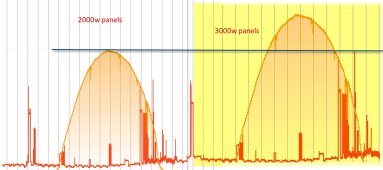HomesteadDad
New Member
- Joined
- Oct 1, 2021
- Messages
- 10
I would like to build an off grid system that I could run a couple freezers and a refrigerator off of, and use as a backup power system if the grid went down for any length. I am looking at buying from signature solar and starting with the growatt 3000 all in one
https://www.signaturesolar.us/produ...id-inverter-by-growatt?variant=39494574899405
I'd also buy from signature solar this battery
https://www.signaturesolar.us/products/24v-200ah-lifepower4-battery-by-eg4?variant=39792056959181
I was looking at used solar panels like these.


I wouldn't use all those panels, as I have some friends who are interested in some panels as well.
One of my questions is what would be the best amount of panels to connect to this system and in what configuration? I live in Michigan, which from what I can find averages 4.1 peak hours of solar per day. I have grid power now, so I'd like to run that as a transfer source. For running my ac loads(fridge, freezer, anything else) I'd like to run the power to a subpanel. Would I need to run busbars, shunts, fuses, etc?
Thank you for any help.
https://www.signaturesolar.us/produ...id-inverter-by-growatt?variant=39494574899405
I'd also buy from signature solar this battery
https://www.signaturesolar.us/products/24v-200ah-lifepower4-battery-by-eg4?variant=39792056959181
I was looking at used solar panels like these.

USA MADE $39 PANELS! 180W 24pc Pallet - UL Listed Solar American Made USED | eBay
Find many great new & used options and get the best deals for USA MADE $39 PANELS! 180W 24pc Pallet - UL Listed Solar American Made USED at the best online prices at eBay! Free shipping for many products!
www.ebay.com

Lot of 20 Used 240W 60 Cell Polycrystalline Solar Panels Vinyl Cracking Silver | eBay
Find many great new & used options and get the best deals for Lot of 20 Used 240W 60 Cell Polycrystalline Solar Panels Vinyl Cracking Silver at the best online prices at eBay! Free shipping for many products!
www.ebay.com
I wouldn't use all those panels, as I have some friends who are interested in some panels as well.
One of my questions is what would be the best amount of panels to connect to this system and in what configuration? I live in Michigan, which from what I can find averages 4.1 peak hours of solar per day. I have grid power now, so I'd like to run that as a transfer source. For running my ac loads(fridge, freezer, anything else) I'd like to run the power to a subpanel. Would I need to run busbars, shunts, fuses, etc?
Thank you for any help.



